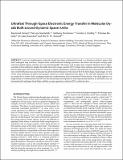Ultrafast through-space electronic energy transfer in molecular dyads built around dynamic spacer units
Abstract
A pair of complementary molecular dyads have been synthesized around a 1,2-diaminocyclohexyl spacer that itself undergoes ring inversion. Despite these conformational exchange processes, the donor and acceptor occupy quite restricted spatial regions, and they are not interchangeable. The donor and acceptor pair comprise disparate boron dipyrromethene dyes selected to display favorable electronic energy transfer (EET). Steady-state emission spectroscopy confirms that through-space EET from donor to acceptor is almost quantitative, aided by the relatively short separations. Ultrafast time-resolved fluorescence spectroscopy has allowed determination of the rates of EET for both dyads. Surprisingly, in view of the close proximity of donor and acceptor (center-to-center separations less than 20 A), the EET dynamics are well-accounted for in terms of the computed molecular conformations and conventional Forster theory. One dyad appears as a single family of conformations, but EET for the second dyad corresponds to dual-exponential kinetics. In this latter case, an intramolecular hydrogen bond helps stabilize an open geometry, wherein EET is relatively slow.
Citation
Ziessel , R , Stachelek , P , Harriman , A , Hedley , G J , Roland , T , Ruseckas , A & Samuel , I D W 2018 , ' Ultrafast through-space electronic energy transfer in molecular dyads built around dynamic spacer units ' , Journal of Physical Chemistry A , vol. 122 , no. 18 , pp. 4437-4447 . https://doi.org/10.1021/acs.jpca.8b02415
Publication
Journal of Physical Chemistry A
Status
Peer reviewed
ISSN
1089-5639Type
Journal article
Description
Funding: University of Newcastle.Collections
Items in the St Andrews Research Repository are protected by copyright, with all rights reserved, unless otherwise indicated.

